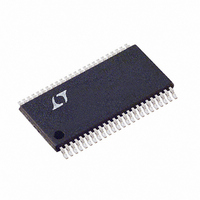LTC1851CFW Linear Technology, LTC1851CFW Datasheet - Page 15

LTC1851CFW
Manufacturer Part Number
LTC1851CFW
Description
IC ADC 12BIT 1.25MSPS 48-TSSOP
Manufacturer
Linear Technology
Datasheet
1.LTC1851CFWPBF.pdf
(28 pages)
Specifications of LTC1851CFW
Number Of Bits
12
Sampling Rate (per Second)
1.25M
Data Interface
Parallel
Number Of Converters
1
Power Dissipation (max)
50mW
Voltage Supply Source
Single Supply
Operating Temperature
0°C ~ 70°C
Mounting Type
Surface Mount
Package / Case
48-TFSOP (0.240", 6.10mm Width)
Lead Free Status / RoHS Status
Contains lead / RoHS non-compliant
Available stocks
Company
Part Number
Manufacturer
Quantity
Price
Company:
Part Number:
LTC1851CFW
Manufacturer:
ABOV
Quantity:
270
Part Number:
LTC1851CFW
Manufacturer:
LT/凌特
Quantity:
20 000
Company:
Part Number:
LTC1851CFW#PBF
Manufacturer:
AD
Quantity:
21
APPLICATIO S I FOR ATIO
Table 2. Input Span Table
It should be noted that the bipolar input span of the
LTC1850/LTC1851 does not allow negative inputs with
respect to ground. The LTC1850/LTC1851 have a unique
differential sample-and-hold circuit that allows rail-to-rail
inputs. The ADC will always convert the difference of the
“+” and “–” inputs independent of the common mode
voltage. The common mode rejection holds up to high
frequencies. The only requirement is that both inputs can
not exceed the V
a bipolar input span is selected the “+” input can swing
exceed V
Integral nonlinearity errors (INL) and differential nonlin-
earity errors (DNL) are independent of the common mode
voltage, however, the bipolar zero error (BZE) will vary.
The change in BZE is typically less than 0.1% of the
common mode voltage.
Some AC applications may have their performance lim-
ited by distortion. The ADC and many other circuits exhibit
higher distortion when signals approach the supply or
ground. THD will degrade as the inputs approach either
power supply rail. Distortion can be reduced by reducing
the signal amplitude and keeping the common mode
voltage at approximately midsupply.
Driving the Analog Inputs
The inputs of the LTC1850/LTC1851 are easy to drive.
Each of the analog inputs can be used as a single-ended
input relative to the input common pin (CH0-COM, CH1-
COM, etc.) or in pairs (CH0 and CH1, CH2 and CH3, CH4
and CH5, CH6 and CH7) for differential inputs. Regardless
of the MUX configuration, the “+” and “–” inputs are
UNI/BIP
full scale relative to the “–” input but neither input can
0
0
1
1
DD
PGA
or go below ground.
0
1
0
1
DD
power supply voltage or ground. When
U
0 – REFCOMP/2
0 – REFCOMP
REFCOMP/4
REFCOMP/2
U
INPUT SPAN
W
REFCOMP = 4.096V
0 – 2.048V
0 – 4.096V
1.024V
2.048V
U
sampled at the same instant. Any unwanted signal that is
common mode to both inputs will be reduced by the
common mode rejection of the sample-and-hold circuit.
The inputs draw only one small current spike while charg-
ing the sample-and-hold capacitors at the end of conver-
sion. During conversion, the analog inputs draw only a
small leakage current. If the source impedance of the
driving circuit is low, then the LTC1850/LTC1851 inputs
can be driven directly. As source impedance increases, so
will acquisition time. For minimum acquisition time with
high source impedance, a buffer amplifier should be used.
The only requirement is that the amplifier driving the
analog input(s) must settle after the small current spike
before the next conversion starts (settling time must be
150ns for full throughput rate).
Choosing an Input Amplifier
Choosing an input amplifier is easy if a few requirements
are taken into consideration. First, to limit the magnitude
of the voltage spike seen by the amplifier from charging
the sampling capacitor, choose an amplifier that has a low
output impedance (<100 ) at the closed-loop bandwidth
frequency. For example, if an amplifier is used in a gain of
+1 and has a unity-gain bandwidth of 50MHz, then the
output impedance at 50MHz should be less than 100 .
The second requirement is that the closed-loop bandwidth
must be greater than 20MHz to ensure adequate small-
signal settling for full throughput rate. The following list is
a summary of the op amps that are suitable for driving the
LTC1850/LTC1851, more detailed information is available
in the Linear Technology Databooks, the LinearView
CD-ROM and on our web site at www.linear-tech.com.
LT
LT1363: 70MHz Voltage Feedback Amplifier. 2.5V to
LT1364/LT1365: Dual and Quad 70MHz Voltage Feedback
Amplifiers. 2.5V to 15V supplies. 7.5mA supply current
per amplifier. Low distortion.
LinearView is a trademark of Linear Technology Corporation.
15V supplies. 7.5mA supply current. Low distortion.
15V supplies. 5mA supply current. Low distortion.
®
1360: 50MHz Voltage Feedback Amplifier. 2.5V to
LTC1850/LTC1851
15
18501f
TM














